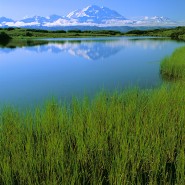Best time of the year to visit Alaska
Although Alaska is a year–round vacation destination, the majority of visitors arrive between mid–May and mid–September.
Travelers in the know visit Alaska in September and May (the shoulder seasons) for great weather and easier booking. Alaska has a short visitor season and can get busy during the peak summer months. Generally, the earlier you reserve space, the better. Princess Alaska Lodges often see peak travel dates full by October of the previous year.
Alaska does not handle the volume of tourists that many other National Park destinations experience. Availability can be limited, particularly in popular destinations such as Denali Park. Reserve your space early to choose the accommodations you really want to experience.
Traveling to Alaska in May
The advantages of early season travel are numerous. The weather is consistently good in May and drier throughout much of the state. Warm spring days aided by long hours of daylight bring Alaska’s wildflowers out in full bloom. The wildlife viewing is also excellent in May since the larger animals are migrating through lower elevations where the snow has disappeared. Alaska is not as crowded in May and it’s easy to take advantage of early season specials and lower rates statewide.
Traveling to Alaska in September
September is also a prime time to visit Alaska. Fall comes early and by Labor Day many of the hardwood trees have turned brilliant colors. Combine the bright yellow colors of the aspen and willow trees with the blazing red tundra plants and you have a unique fall colors experience. You will see why Polychrome Pass in Denali National Park earns it name.
The tallest mountains have fresh snow on their peaks while the lower elevations are still dry. Larger mammals begin feeding in the lower elevations in an attempt to pack on as much winter weight as possible, so wildlife search opportunities improve. Days are warm and nights are chilly. Plus, it gets dark enough in the Interior of Alaska to see the Northern Lights.
What month in Alaska is the warmest?
Alaska is warmest in the month of July with a daily average temperature that sits around 67 °F. June and August are also warmer months; however, they tend to fluctuate a bit more than July does.
What is the cheapest month to visit Alaska?
The most inexpensive time to visit Alaska is during the off-season when fewer tourists are visiting the state. This off-season starts in late September and goes through April. Oftentimes you are able to find lower prices on flights and accommodations during this off season.
What is the most expensive month to go to Alaska?
The most expensive time of the year to visit Alaska is usually July. July is peak tourist season with the warmer weather conditions. Although flights, accommodations, and activities are in high demand and may be more expensive at that time, many people find that it’s worth the price to visit Alaska even at that time.
Whether you’re drawn to the allure of Denali’s towering peaks, the calving glaciers of Glacier Bay, or the untamed beauty of the Inside Passage, planning ahead ensures you make the most of your Alaska adventure.
